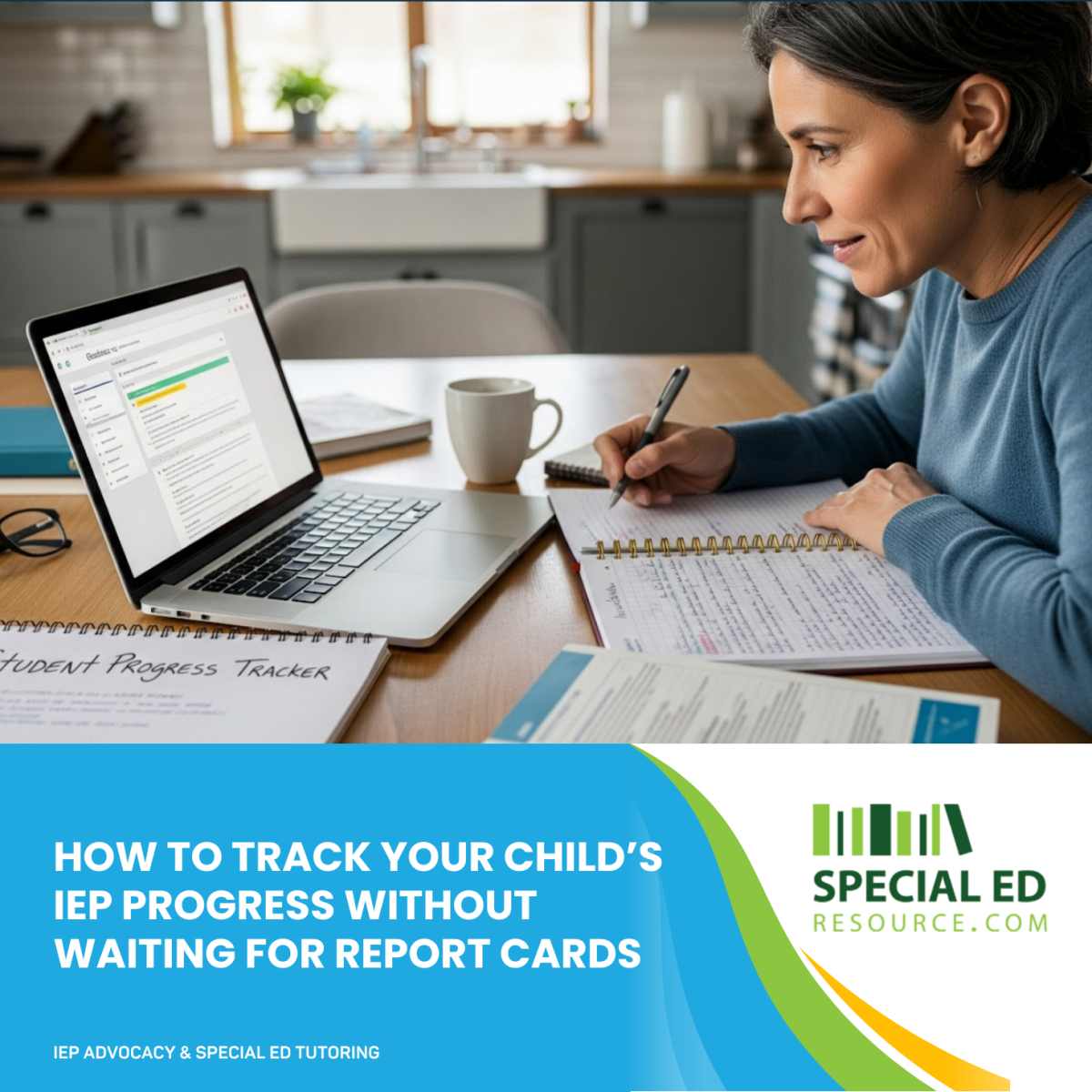By: Press Services
October 30, 2025
How to Track IEP Progress Before Report Cards Arrive
Tracking IEP Progress: A Parent’s Guide to Measuring Growth Without Waiting for Reports
United States - October 30, 2025 / Special Ed Resource LLC /
 Tracking IEP Progress: How Parents Can Monitor Growth Without Waiting for Report Cards
Tracking IEP Progress: How Parents Can Monitor Growth Without Waiting for Report CardsWaiting for report cards can feel like holding your breath. For parents of children with special needs, that wait often comes with a mix of hope, anxiety, and uncertainty.
Progress reports tell part of the story – but only part. Real growth happens in small, everyday moments that never make it onto a grade sheet. Understanding how to track IEP progress between official updates gives parents the clarity and confidence they need to advocate effectively for their child.
That’s where Special Education Resource shines. Their team of special education tutors and advocates helps families turn IEP data into insight – ensuring no progress (or problem) goes unnoticed.
Why Waiting for Report Cards Isn’t EnoughReport cards are designed for general education, not individual education plans. For students with special needs, grades alone rarely reflect actual growth.
IEPs are meant to measure personalized progress – how well a child is meeting their unique goals, not how they compare to peers. Unfortunately, many parents don’t receive detailed updates until formal review meetings or end-of-term reports.
By then, valuable months may have passed. If a strategy isn’t working or a goal isn’t realistic, that delay can set a child back unnecessarily.
The good news: parents have the right – and the ability – to track IEP progress year-round. With the right tools and guidance, they can make sure every milestone, big or small, is recognized and used to improve future instruction.
Partnering with an experienced IEP advocate ensures those details are never missed, and every opportunity for growth is maximized.
Understanding IEP Progress Data: What to Look ForAn IEP isn’t just a legal document – it’s a roadmap. Every measurable goal, service, and support written into it tells you what progress should look like.
The most important indicators of IEP progress include:
Baseline Data: The child’s starting point for each goal.
Progress Measurements: How growth is being tracked – for example, through tests, classwork, or teacher observations.
Frequency of Data Collection: How often the school gathers data (weekly, monthly, quarterly).
Reporting Schedule: How often the school communicates progress to parents.
Each of these details should be clearly outlined in the IEP. If they aren’t, that’s a red flag. Families have the right to ask for clarification or updates at any time.
An expert in IEP consulting can help parents interpret the technical language and ensure that progress reporting is both consistent and meaningful.
How to Monitor IEP Progress at HomeTeachers track data in the classroom – but parents see progress in real time. The way a child handles homework, expresses frustration, or masters a daily routine can reveal as much as any formal test.
Here’s how parents can monitor growth at home:
1. Keep a Simple Progress JournalNote small changes: improved handwriting, faster reading, better transitions, or calmer behavior during challenging moments. These observations create valuable context for school data.
2. Ask for Work SamplesRequest examples of classwork that show progress (or lack of it) over time. Comparing earlier and recent work can reveal growth trends and help guide next steps.
3. Communicate Regularly with TeachersA short monthly email or check-in can prevent surprises later. Ask specific questions, like:
“What data are you collecting for this goal?”
“Have you noticed new strengths or challenges?”
If a child suddenly resists a subject they once enjoyed, it may signal confusion or frustration. Emotional responses are often early indicators of academic issues.
5. Use Technology WiselyDigital learning tools and progress trackers can help visualize skill development. Some apps allow parents to log data alongside teachers for a more complete view.
When parents combine their observations with school data, they build a stronger case for what’s truly working – or not – in their child’s education.
When Progress Seems StalledIt’s normal for progress to slow down occasionally. But when a student consistently falls short of their IEP goals, parents shouldn’t wait until the annual review to take action.
If progress data shows little or no improvement, the IEP team may need to:
Adjust the teaching strategy or service frequency.
Provide additional accommodations or modifications.
Reassess the student’s current needs and goals.
The Individuals with Disabilities Education Act (IDEA) gives parents the right to request an IEP meeting at any time. Having detailed, real-world progress notes strengthens their voice in that discussion.
Many families work with professional advocates from Special Education Resource who help identify gaps, interpret data, and prepare the right questions to ask during meetings. Their experience ensures that the IEP evolves alongside the child – not behind them.
Collaborating with Teachers and IEP TeamsIEP progress tracking isn’t a “checklist” – it’s a collaboration. Parents, teachers, and specialists all see different sides of the same student, and each perspective matters.
Effective collaboration involves:Open communication: Regular updates through email or shared documents.
Data transparency: Access to ongoing assessments and work samples.
Consistency across settings: Reinforcing strategies both at school and at home.
Shared accountability: Everyone involved in the IEP shares responsibility for progress.
Parents can encourage this teamwork by staying informed and engaged – not adversarial. When the IEP team feels like a partnership, the child’s needs stay at the center.
Advocates from Special Education Resource often serve as bridges in this process, helping translate educational jargon into clear, actionable steps for families.
How IEP Advocates Help Parents Track and Interpret ProgressMany parents feel overwhelmed by the data in IEPs – or unsure what it all means. An IEP advocate acts as a guide through that complexity.
Special Education Resource’s advocacy services help parents:
Review IEP documents for accuracy and completeness.
Clarify unclear goals, accommodations, or progress measures.
Identify missing or ineffective supports.
Prepare targeted questions for IEP meetings.
Understand and track growth between formal updates.
By partnering with an advocate, parents gain confidence in their ability to ensure the IEP truly serves their child. It’s not about confrontation – it’s about collaboration, clarity, and results.
Learn more about how professional advocates can support families through every stage of the process at Special Education Resource’s IEP Advocate page.
Signs of Meaningful IEP ProgressHow can parents tell when an IEP is working? The evidence goes beyond test scores.
Meaningful progress often looks like:
Increased confidence and willingness to try new tasks.
Improved social interaction or emotional regulation.
Independence with homework or daily routines.
Greater consistency in meeting IEP goals over time.
These are the real wins that build a foundation for lifelong learning. Recognizing them helps families stay motivated and reinforces that growth is happening – even when it’s gradual.
About Special Education ResourceSpecial Education Resource is a national leader in individualized learning and IEP advocacy. Founded by Luke and his wife after navigating their own children’s special education journeys, the company was built from experience, empathy, and expertise.
Their mission is to identify and dissolve the root causes of learning struggles – helping students not just catch up, but accelerate with confidence. Through personalized tutoring, homeschool support, and IEP consulting, Special Education Resource helps families transform frustration into progress.
With one-on-one and group services available, they make specialized education accessible, effective, and empowering for families across the United States.


Contact Information:
Special Ed Resource LLC
,
United States
Luke Dalien
(844) 773-3822
https://specialedresource.com/
This contant was orignally distributed by Press Services. Blockchain Registration, Verification & Enhancement provided by NewsRamp™. The source URL for this press release is How to Track IEP Progress Before Report Cards Arrive.
